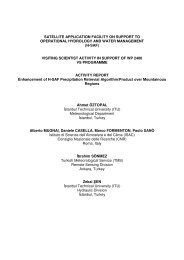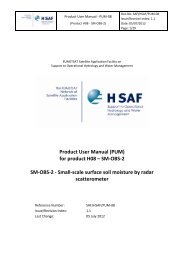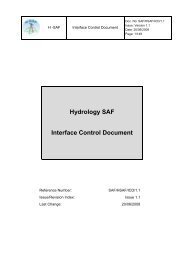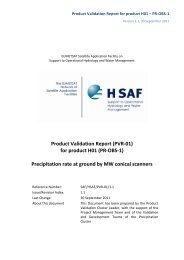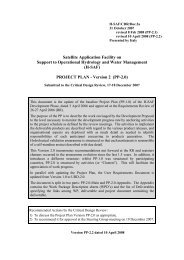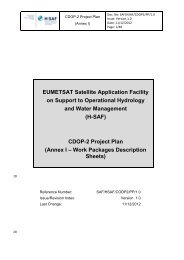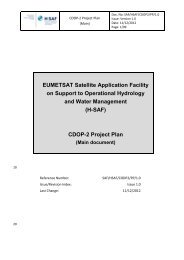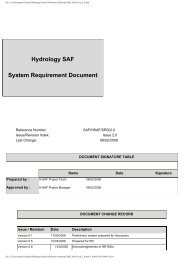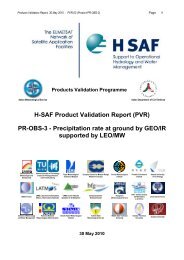Zuhal Akyurek, A. Unal Sorman - H-SAF
Zuhal Akyurek, A. Unal Sorman - H-SAF
Zuhal Akyurek, A. Unal Sorman - H-SAF
You also want an ePaper? Increase the reach of your titles
YUMPU automatically turns print PDFs into web optimized ePapers that Google loves.
Summary<br />
Snow covered area depletion curves represent a key input for snow runoff melting models<br />
like the snowmelt runoff model (SRM). SRM is a degree-day-based model for daily runoff<br />
simulations and forecasts in mountainous areas in which snowmelt is the major runoff<br />
contributor. Satellite images and aerial photographs are valuable sources for retrieving<br />
snow covered areas on non-cloudy days. The accuracy of the snow cover mapping studies<br />
in the optical wavebands mostly depends on the algorithm's ability to detect clouds. On<br />
very cloudy days it is not possible to make accurate snow cover mapping using only optical<br />
sensors. Microwave sensors can be used to obtain snow information on cloudy days. The<br />
snow-water equivalent (SWE) of a dry snow pack can be estimated with passivemicrowave<br />
sensors such as Special Sensor Microwave/Imager (SSM/I) and Advanced<br />
Microwave Scanning Radiometer for EOS (AMSR-E). Development of snow cover<br />
products based on multi-sensor data sources is needed for continuous regional and global<br />
snow cover mapping for climate, hydrological and weather applications. The proposed<br />
algorithms for snow recognition and effective snow cover products do not take the optic<br />
and microwave data into account at the same time. However the optical data do not provide<br />
information on cloudy days. In order to evaluate snow cover maps obtained by MSG-<br />
SEVIRI, NOAA/AVHRR, Terra-Aqua-EOS/MODIS, the blending methodology of snow<br />
products obtained from MODIS and AMSR-E, will be implemented and tested for<br />
mountainous areas.<br />
A preliminary blended snow product has been developed jointly by the U.S. Air Force<br />
Weather Agency (AFWA) and NASA / Goddard Space Flight Center. The AFWA – NASA<br />
or ANSA blended snow product is an all-weather product that utilizes both visible and<br />
near-IR (MODIS) and microwave (AMSR-E) data. In this study the validation of the<br />
ANSA blended snow cover product, having 25 and 5 km spatial resolution, respectively,<br />
was performed for the eastern part of Turkey for five months in the winter of 2007-2008.<br />
This is the first time that the blended snow cover product has been evaluated in a<br />
mountainous area, where the elevation ranges between 850 and 3000 m. Daily snow data<br />
collected at 36 meteorological stations were used in the analysis. The utility of ANSA<br />
products in mountainous areas of Slovakia covered with forest was also analyzed. The<br />
ANSA blended snow products improve the mapping of snow cover extent relative to using<br />
either MODIS or AMSR-E products, alone, for the 2007-08 winter in the eastern part of<br />
Turkey. However in Slovakia ANSA products do not improve the mapping of snow cover<br />
extent. 5 km resolution ANSA prototype ANSA maps from February and March 2008 were<br />
used to derive snow cover depletion curves for the upper Euphrates basin located in the<br />
eastern part of Turkey. The results are compared with the curves obtained from MODIS<br />
daily snow products, and found to provide an improvement over using MODIS daily maps<br />
alone. This is because of cloud obscuration on the MODIS maps.<br />
1




